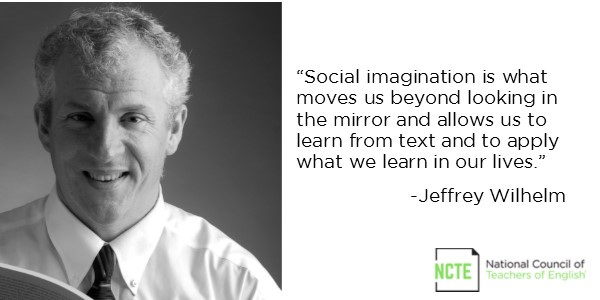This post is written by member Jeffrey Wilhelm.
The third edition of “You Gotta BE the Book!” Teaching Engaged and Reflective Reading with Adolescents ( YGBB) was recently released (NCTE/Teachers College Press). It’s been 20 years since the first edition appeared, and I was struck with how the findings of the book are even more important to me—urgently so—as a teacher today than they were when the book was first published.
Here is the central takeaway to me, particularly as we are living in the era of next generation standards: reading is much more and much greater than a repertoire of strategies. The most engaged reading involves imagination, joy, relationship, and even transformation.
Here is the major payoff and what is most at stake: personal development, social imagination, and the evolution of democratic ways of living.
I happen to like—as far as they go—most of the next generation standards (like the Common Core and the Next Generation Science Standards) with which I have worked over the last few years. However, these certainly do not go far enough. That means that extending these standards and filling their gaps is up to us as teachers. YGBB is highly relevant in this regard: the book explores the participatory, visual, emotional, psychological, embodied, imaginative, connective, and reflective stances and strategies of expert readers and discusses how to promote and support these with students. These dimensions are prerequisite to and supportive of the cognitive dimensions highlighted in current standards documents.
My research found that disengaged readers do not understand and have not experienced what real engaged reading is, nor how they can practice it. Teaching approaches that exclusively promote or even privilege decoding or cognitive strategies exacerbate the problem of disengagement because such approaches miss the wonder of the lived-through experience of reading. These slighted dimensions of the reader’s repertoire make this wonder, the joy and the transformation, possible.
Often in school, we ask students to answer questions and reflect about an experience that they have not had and that instruction has not supported them to have. Of course, they might think, as my case study student Marvin asserted, “Reading is STUPID!”
Now, more than ever, we need to promote purpose in reading (both in terms of functional application and pleasure), high expectation of text, participation in creating and living through textual worlds, and the visualization and embodiment of these secondary worlds. In the intervention research that followed the research describing the dimensions of engaged readers’ response, I found that strategies to promote participation, like drama in education strategies (see Wilhelm, 2013a for a full treatment), and to promote seeing what one is reading through visualization strategies (Wilhelm, 2013b) led disengaged readers to a richer construal of reading and to the capacity to construct rich and personally significant meanings with text.
Nevertheless, perhaps the most important finding was that these collaborative meaning-making approaches were both prerequisite and foundational to cognitive connective, inferential, and reflective kinds of reading and to the cultivation of what might be called social imagination. Social imagination can be defined as the capacity to see the world from a variety of perspectives, and to experience and learn from cultural situations and worlds that are distant from one’s own experience, time, or place. Social imagination is what moves us beyond looking in the mirror and allows us to learn from text and to apply what we learn in our lives.
For learners to become engaged and democratic citizens and workers, they need to practice skills that develop social and ethical imagination and agency. Without this cultivation of social imagination, there can be no personal development, no outgrowing of the current self, and no social transformation of the networks of which one is a part.
Social imagination is also developed when students collaboratively connect, discuss, and reflect on the meanings of text, particularly regarding what texts mean about how we should be and live in our world. The text, in effect, is a secondary world that helps us to imaginatively rehearse how to be in the primary world.
It is a Vygotskian insight that thinking together helps us think in new ways, and thinking well together is prerequisite to thinking powerfully in ways that are more independent.
If we care about the development of our students as individuals who can relate to and appreciate and care for others; if we care about the development of the democratic communities our students will participate in; if we care about democratic living and work; if we care about attention to one’s own growth and to the needs of others, then we need to teach engaged and reflective reading. The third edition of YGBB explores why this is of paramount importance now, why teaching to standards is not enough, and how to teach for the bigger purposes of joy, imagination, love, and transformation.
Works Cited
Wilhelm, J. (2016). “You gotta BE the book!”: Teaching engaged and reflective reading with adolescents (3rd ed.). New York: Teachers College Press.
Wilhelm, J. (2013a). Deepening comprehension with action strategies (2nd ed., including DVD). New York: Scholastic.
Wilhelm, J. (2013b). Enriching comprehension with visualization strategies (2., including DVD). New York: Scholastic.
Jeffrey D. Wilhelm is Distinguished Professor of English Education at Boise State University who teaches and co-teaches middle and high school classes each year. He is the author or co-author of 37 books about literacy teaching, the winner of the NCTE Promising Research Award, and two-time recipient of the David H. Russell Award for Distinguished Research in English Education.

